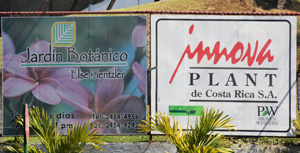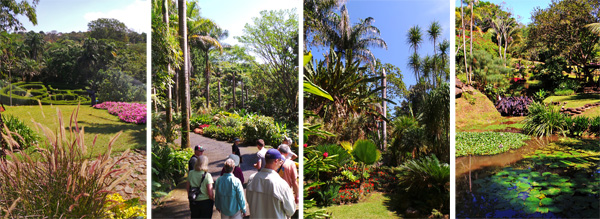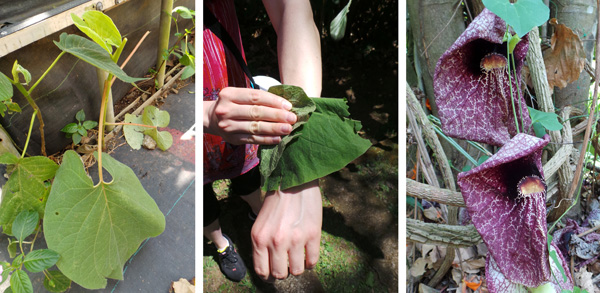Else Kientzler Botanical Garden is a private garden in Sarchi with a collection of tropical plants from around the world, with over 2000 species of plants in 11 gardens and some native forest on 17 acres. It includes collections of palms, gingers, aquatic plants, bromeliads, fruit trees, tropical timber trees, ornamental plants, succulents and orchids. The garden was started in 1998 on an old coffee farm by Mr. Ludwig Kientzler, president of Innovaplant de Costa Rica, an ornamental plant export business that operates adjacent to the Garden (and you have to drive through to get to the Garden). It was officially opened in 2006, named after his mother Else, who for many years managed the family-run German company that is Innovaplant de Costa Rica’s parent company. The garden is subsidized by the German company, providing 40% of its operating expenses.
Our local guide, Randall, told us about various plants as we went along, stopping to explain in his limited English (he explained that he was still learning English so would appreciate help, so everyone supplied words when he faltered, but he actually did a very good job) interesting facts and features about the plants. He told us about elephant foot palm (also called ponytail palm, Nolina or Beaucarnia recurvata, native to eastern Mexico) which isn’t really a palm, but its grey, swollen base really did resemble an elephant’s foot; pointed out the brilliant red passionflower (Passiflora vitifolia) and explained how it got its common name; discussed a little about bananas and how they grow, flower and produce fruit; showed us the smooth and shiny bark of the guava tree (Psidium guajava, asmall tree in the Myrtle family (Myrtaceae), native to Mexico, Central America, and northern South America) that makes it difficult for pathogenic fungi to cling to it and cause infections; and many more plants.
Ponytail palm or elephant foot palm, which is not a true palm (L); the group listens to local guide Randall (LC) tell about Passiflora vitifolia (RC); and looking up a guava tree (R).
We headed up a slope past some shrubs with white powderpuff flowers (Calliandra haematocephala ‘Alba’, native to Borneo), for a better look at a blooming poró tree and a water apple tree (Syzygium samarangens, native to Malaysia, also called Malay apple) where Randall found an almost-ripe fruit for the group to taste; the tree was loaded with thousands of green fruits.
Calliandra haematocephala ‘Alba’ (L); the group taking pictures of the poró tree (LC) and close up of the flowers of the poró tree, Erythrina poepiggiana (RC); and water apple fruits (R).
From there we headed to the shaded nursery area where they raise some of the plants that will eventually go into the gardens. Randall showed us their vermiculture bins under black plastic in one part of the shade house. As we continued along, he picked a large heart-shaped, velvety leaf of Piper auritum, native from northern South America to Mexico, and growing as a weed, and demonstrated how the crumpled leaf with a light anise scent (also described as having hints of eucalyptus, black pepper, nutmeg or mint) can be rubbed on the skin as a natural insect repellent. I later learned it is used to wrap tamales in some Mexican cuisines and is used as an essential ingredient in mole verde in the Oaxaca region of Mexico and in other ways in other parts of Mexico.) From there we went by a blooming Aristolochia gigantea (native to Brazil) with several smelly purple flowers hanging off the vines, and many other interesting blooming bromeliads, palms and ornamentals.
Velvety leaf of Piper auritum (L) and Kari rubbing a leaf to repel insects on her arms (C); and flowers of Aristolochia gigantea (R).
Then we hiked up the paved road shaded by very tall palms, stopping briefly to look at the piles of soil excavated by leafcutter ants constructing their nest in the grass across the way, until we reached the reception building. Some of us went upstairs to cross over the bridge to the succulent garden, but it was getting pretty hot, so most people just viewed it from afar.
Leafcutter ant mounds (L); Madagascar native Euphorbia stenoclada in the succulent garden (C) and a view of tall plants in the succulent garden (R).
We also managed to fit in some cultural activities today. Prior to visiting the botanical garden, we had stopped in San Ramon to see the bakery owned by the family of our guide Gustavo (and of course had to sample some treats or purchase things to take home).
Dwight and Gustavo look in the refrigerated case while another customer looks on (L); a selection of goodies in the case (LC); shelves full of cookies and other pastries (RC); and the group outside the bakery (R).
After the Garden, we had lunch at Fabricia de Carretas de Eloy Alfaro, a painted oxcart factory where we got to see how the iconic carretas (that traditionally carried coffee from the highlands down to the port on the Pacific coast) are constructed and decorated in elaborate designs of bright colors.








